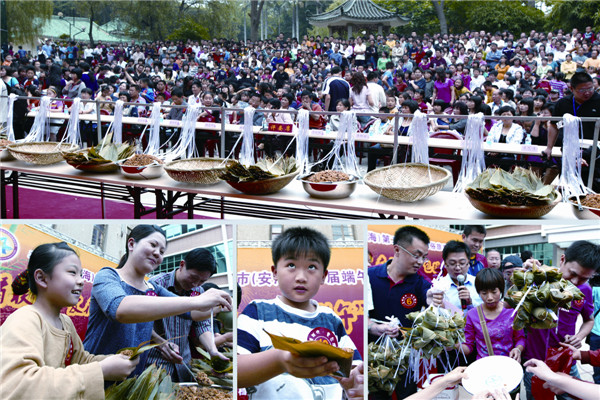 |
| The crowd on Anping Bridge on the Dragon Boat Festival.[Photo by Huang Qifang] |
Historical records say the dragon boat race was started by Goujian and the second volume of the Fenghuajili, written by Tanghan, says that the festival was originally established in memory of Qu Yuan and later developed by Goujian as a common practice. The Jinchu Chronicle says, “On the fifth day of the lunar month of May, Qu Yuan plunged into the Miluo River and tried to kill himself. Boats were sent to save him.” So it is clear that saving the poet Qu Yuan was the real purpose of dragon boat rowing.

[Photo by Huang Huaming]
In the distant past, there was no one fixed style for the boats or names for the boats. Then, later, because the Min- Yue ethnic group worshipped the dragon as a form of protection from God, the boats were built and painted in the style of a dragon and were given names like “dragon boat” or “dragon ship”. Today, we can see eyes painted on boats in Jinjiang that are called “dragon’s eyes”.

[Photo by Xu Weigeng]
Jinjiang folks replaced the term “Dragon boat paddling” with “Dragon boat rowing”, where paddling means paddling slowly and leisurely, but rowing needs oarsmen to bend their bodies forward and make a great effort to row as fast as possible to save Qu Yuan. Over the long course of evolution, this “Dragon boat rowing” has become a water sport. These types of dragon boat have a special design, with a wooden dragon head rising up at the bow and dragon eyes open wide. The stern has an elaborately carved tail and there are dragon scales painted all over the entire body so the boat seems like a real living dragon. The body is shallow and flat, with a fixed position on each side for the rowers. For the race, the boats are arranged in a line and, as soon as the starting gun fires, the rowers row as fast as possible, with commands from the coxswain in the bow. The boats race ahead and the audience on the banks wave flags and shout slogans or honk horns. The first dragon boat over the line draws thunderous applause and there are firecrackers for celebration.

Shidi
And there are many other Dragon Boat Festival traditions than just the rowing, such as hanging an Aizhi palm branch on the door, or making pancakes, or noon salty tea, wearing flagarant bags and five-colored thread , drinking certain wine , smearing the palms of children with vermilion, and singing lotus-gathering songs for the Dragon King. Then there is the story about the custom of wrapping up zongzi. The Xuqixie says that people filled bamboo tubes with rice and threw them into rivers in memory of Quyuan and later in the Jianan era of the Han Dynasty, Oujian, a man of Changsha, met Quyuan in some stange way and Quyuan told him that the rice the people threw had been swallowed by water dragons. So, Quyuan suggested that they wrap the rice up and bind it with five-colored thread to frighten the dragons away and keep them from eating the food. Nonetheless, the rice and meat are wrapped in bamboo leaves called “Zong leaves” and tied up with fine salt herbs instead of five-color thread.
Protecting against evil at the Dragon Boat Festival
Overseas Chinese from Jinjiang always hang an aromatic plant, such as ‘ai’ and calamus, to counteract evil forces and some people paste couplets on each side of the door, reading “calamus drive away evil and bring good luck, and ‘ai’ leaves counteract evil forces and secure safety”.
This custom is said to have originated from the Western Jin, where a scholar named Dengyou was the head of Wu prefecture (today’s Suzhou) and he did much good and was loved by the local people.
At the end of Yongjia period, because of upheaval amng the eight princes, Wu prefecture was occupied and many local people fled. Dengyou fled south with his wife, putting his son and his nephew in baskets. When they reached Sishui, they were almost captured by the enemy. Dengyou saw that it was impossible for him to protect the two children at the same time and decided to leave his son alone on the road.
Then, unexpectedly, they were caught by the soldiers and Shile tried to kill Dengyou, but then discovered that Dengyou had abandoned his son to save his nephew and plucked an ‘ai’ branch and calamus and put them on Dengyou and his wife and nephew and told his soldiers that anyone who had ‘ai’ and calamus on him should be spared.
Dengyou arrived at Shibi in Fujian on the 5th day of the lunar month of May and was worried about the safety of the people there. He remembered what Shile had told every family to put ‘ai’ and calamus in their doors and, sre enough, when the soldiers came they left quickly without killing anybody.
After the upheaval, people migrated from Shibi to other parts of Fujian, but they never forgot what Dengyou had done for them. So, on Dragon Boat Festival, they hang ’ai’ and calamus on their doors in commemoration and to drive away evil forces and pray for good luck. That practice started almost 1,700 years ago at the end of the Western Jin.